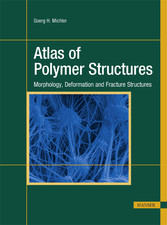Goerg H. Michler
Atlas of Polymer Structures
Morphology, Deformation and Fracture Structures
Contents
7
Part.I – Introduction
13
1 Overview
15
1.1 Aim of the Atlas
15
1.2 Molecular Structures
19
1.2.1 Constitution
19
1.2.2 Configuration
19
1.2.3 Conformation
21
1.3 Supramolecular Structures and Morphology
23
1.3.1 Homopolymers
23
1.3.2 Copolymers
25
1.3.3 Polymer Blends
26
1.3.4 Composites
27
1.3.5 Additional Morphologies
30
1.4 Mechanical Behavior
30
1.4.1 Types of Deformation
30
1.4.2 Deformation Mechanisms
32
1.4.3 Fracture
34
2 Techniques and Methods
39
2.1 Microscopic Techniques
39
2.2.1 Overview
39
2.1.2 Optical Microscopy
40
2.1.3 Scanning Electron Microscopy
40
2.1.4 Transmission Electron Microscopy
43
2.1.5 Atomic Force Microscopy
45
2.1.6 Image Processing and Image Analysis
45
2.2 Sample Preparation Methods
47
2.2.1 Overview
47
2.2.2 Preparation of Surfaces
51
2.2.3 Preparation of Thin Sections
55
2.2.4 Contrast Enhancement
59
2.2.5 Stereoscopic Imaging and 3D Analysis
63
2.3 Deformation and Fracture Tests
64
3 Influences of Techniques and Methods on Micrographs
69
3.1 Influence of Sample Preparation
69
3.1.1 Influence of Fracture Processes
69
3.1.2 Influence of Section Thickness
69
3.2 Influence of Investigation Parameters in.TEM
73
3.2.1 Influence of Electron Beam Intensity
73
3.2.2 High-Resolution Micrographs
77
3.2.3 Tilting of the Specimen in TEM
78
Part.II – Groups of Polymers
81
1 Amorphous Polymers
83
1.1 Main Characteristics
83
1.1.1 Structure and Morphology
83
1.1.2 Deformation Mechanisms
87
1.2 Homopolymers
94
1.2.1 Polystyrene (PS)
94
1.2.2 Poly(methyl methacrylate) (PMMA)
107
1.2.3 Poly(vinyl chloride) (PVC)
111
1.2.4 Polycarbonate (PC)
116
1.3 Copolymers
122
1.3.1 Styrene Acrylonitrile Copolymers (SAN)
122
1.3.2 Cyclic Olefin Copolymers (COC)
127
2 Semicrystalline Polymers
133
2.1 Overview
133
2.1.1 Lamellar Structure
135
2.1.2 Structural Hierarchy
139
2.1.3 Parameters Influencing Morphology
142
2.1.4 Deformation and Fracture Mechanisms
144
2.2 Polyethylenes
151
2.2.1 High-Density Polyethylene (Linear PE, HDPE)
151
2.2.2 Ultrahigh Molecular Weight Polyethylene (UHMWPE)
168
2.2.3 Low-Density Polyethylene (Branched PE, LDPE)
178
2.2.4 Linear-Low Density Polyethylenes (LLDPE, VLDPE)
193
2.3 Polypropylene (a-, ß-iPP, sPP)
203
2.3.1 PP Morphology
203
2.3.2 PP Deformation and Fracture Structures
210
2.4 Additional Polymers (PA, PVDF, PBT, PEN, PEEK, POM, PEO, sPS)
220
2.4.1 Morphology
220
2.4.2 Deformation and Fracture
229
3 Block Copolymers
235
3.1 Overview
235
3.1.1 Morphology of Block Copolymers
236
3.1.1.1 Nanostructures via Self-Assembly
236
3.1.1.2 Influence of Chain Architecture
237
3.1.1.3 Block Copolymer/Homopolymer Blends
238
3.1.1.4 Processing-Induced Nonequilibrium Morphologies
239
3.1.1.5 Block Copolymer Nanocomposites
241
3.1.2 Deformation Mechanisms in Block Copolymers
241
3.2 Block Copolymers – Morphology
249
3.2.1 Morphology of Diblock and Triblock Copolymers
249
3.2.2 Morphology of Block Copolymer / Polymer Blends
258
3.3 Deformation and Fracture Structures
266
4 Polymer Blends
281
4.1 Overview
281
4.1.1 Morphology
282
4.1.2 Deformation Mechanisms
286
4.2 Blends of Amorphous Polymer Components
290
4.2.1 Morphology of the Blends
290
4.2.2 Deformation and Fracture Structures
294
4.3 Blends of Amorphous and Semicrystalline Polymers
299
4.3.1 PE/PS Blends, Morphology, and Deformation Structures
299
4.3.2 PP Blends with PS and PEO
303
4.3.3 Blends of TPU with SAN and ABS
305
4.3.4 Blends of PBT/PET with PC
308
4.3.5 Blends of PA with ABS, HIPS, and sPS
311
4.3.6 PE Multiphase Blends
315
4.4 Blends of Semicrystalline Polymers
317
4.4.1 Blends of HDPE, LDPE, and VLDPE
317
4.4.2 PE/PP Blends
322
4.4.3 PP/PA Blends
325
4.4.4 PBT, PET Blends (with EVA, PE, PP, PA)
327
4.5 Rubbers and Elastomers
329
4.5.1 NR and SBR Blends
329
4.5.2 EVA Copolymer
335
4.5.3 Polyurethanes (PU, TPU)
335
4.5.4 Further Elastomers
339
5 Rubber-Toughened Polymers
343
5.1 Overview
343
5.1.1 Morphology
343
5.1.2 Basic Micromechanical Mechanisms
346
5.2 Systems with an Amorphous Matrix
354
5.2.1 High-Impact Polystyrene (HIPS)
354
5.2.1.1 Morphology
354
5.2.1.2 Deformation Mechanisms
360
5.2.2 Acrylonitrile-Butadiene-Styrene (ABS)
370
5.2.2.1 Morphology
370
5.2.2.2 ABS Deformation Mechanisms
376
5.2.3 Rubber-Modified SAN: SAN/EVA, SAN/CPE (ACS), SAN/PBA (ASA)
390
5.2.4 Rubber-Toughened PMMA (RTPMMA)
397
5.2.5 Additional Amorphous Rubber-Toughened Polymers (Rubber-Toughened PC, COC, Epoxy)
404
5.2.6 Rubber-Toughened PVC
410
5.2.6.1 Toughened PVC with Disperse Structure
410
5.2.6.2 Toughened PVC with Network Structure
417
5.3 Systems with Semicrystalline Matrix
424
5.3.1 Rubber-Modified Polypropylene (PP)
424
5.3.2 Rubber-Modified Polyamide
436
6 Composites
439
6.1 Main Characteristics
439
6.1.1 Particle-Filled Polymer Composites
439
6.1.2 Nanoparticle Polymer Composites
444
6.2 Particle-Filled Polymer Composites
450
6.2.1 Morphology
450
6.2.2 Deformation Structures
457
6.3 Nanoparticle-Filled Polymers (Nanocomposites)
461
6.3.1 Morphology
461
6.3.2 Deformation Structures
470
7 Fiber-Reinforced Polymer Composites
7 Fiber-Reinforced Polymer Composites
7.1 Overview
475
7.2 Inorganic and Carbon Fiber Polymer Composites
481
7.3 Polymer-Polymer Composites and Natural Fiber Composites
487
8 Biopolymers and Polymers for.Medical Applications
497
8.1 Overview
497
8.1.1 Biobased and Biodegradable Polymers
498
8.1.2 Biomedical Polymers
499
8.2 Biobased Polymers
509
8.3 Medical Applications
518
9 Special Processing Forms
539
9.1 Overview
539
9.2 Hot-Compacted Fibers and Films
551
9.3 Coextruded Multilayered Polymers
553
9.3.1 Morphology
553
9.3.2 Deformation Structures
564
9.4 Nanofibers
570
9.5 Polymeric Foams and Membranes
579
Part.III – Tables
589
Table.1 Connection of Polymers with Morphological Details and.Deformation Structures
591
Table.2 Appearance of Morphological Details in Polymers
598
Table.3 Deformation and Fracture Structures in Polymers
602
Table.4 Structural/Morphological Details with Culinary or Natural.Backgrounds
604
List of Abbreviations
605
Subject Index
611
© 2009-2024 ciando GmbH
 Zu Hanser-Fachbuch.de
Zu Hanser-Fachbuch.de
 Warenkorb
Warenkorb
